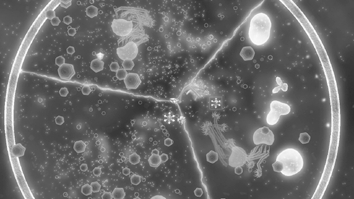




**microscope
n. 显微镜
**protein
n. 蛋白质 adj. 蛋白质的
**mosquito
n. 蚊子
【记】“貌似黑头”→像鼻子上的黑头→蚊子
**bacteria
n. 细菌
*immature
adj. 发育未全的;不成熟的
【记】im(不)+mature(成熟)→不成熟的
【例】She said I was too immature to get married.

*vital
adj. 活的,有生命的;维持生命必需的
*biotic
adj. 生物的;有关生命的(biological)
【例】The digestive system, cholesterol level and immune system are all claimed to benefit from these biotic drinks.
*nostril
n. 鼻孔
*ripeness
n. 成熟,老练(maturity)
【例】Roasting fruit perfectly depends on its ripeness, so baste the pears and check on them often.
*squid
n. 枪乌贼,鱿鱼
*flea
n. 跳蚤(a small jumping insect without wings that feeds on the blood of animals and humans)
*exhalation
n. 呼气;蒸发,散发(evaporation; vaporization);散发物
【例】She shook her head again, this time with a horsey, nasal exhalation of disgust.
*immune
adj. 免疫的(unaffected; unsusceptible);免除的
【记】im(没有)+mune(责任)→没有责任→免除的
【例】I had the mumps when I was six, so now I am immune.
*biosphere
n. 生命层,生物圈
【记】bio(生命)+sphere(球,圈)→生物圈
**microorganism
n. 微生物,细菌(bacterium)
【记】micro(微小)+organism(生物)→微生物
**biodiversity
n. 生物多样性(biological diversity)
【例】The judges also found that the poster demonstrated a clear understanding of the challenges to biodiversity.
**homogeneity
n. 同质,同种(homogeneousness)
【例】Some bloggers said Poland’s ethnic homogeneity may have played a role in changing the photo.
*antibiotic
n. 抗菌素,抗生素(如青霉素)adj. 抗菌的,抗生的
*proliferate
v. (使)繁衍,(使)增殖;(使)增加(to multiply; increase)
【记】pro(前)+lifer(后代)+ate→繁衍,增殖
【例】Autumn is the best season for crab to proliferate.
*specimen
n. 标本,样品(sample; instance)
*subsist
vi. 生存(to live; survive)
【例】The poor farmer’s family subsisted on potatoes.
*propagate
v. 繁殖(to multiply; proliferate);传播
【例】Plants won’t propagate in these conditions.
*assimilate
vt. 同化;吸收(to absorb; integrate; incorporate)
【记】as+simil(相同)+ate→使相同→同化,吸收
【例】I have not quite assimilated the new rules so I sometimes violate them by mistake.
*mutant
n. 突变体,突变型(living thing that differs basically from its parents as a result of genetic change; mutation)
*cellular
adj. 细胞的,由细胞组成的(of or consisting of cells)
【例】cellular tissue 细胞组织
**biomass
n. (单位面积或体积内的)生物量
*metamorphosis
n. 变形;蜕变
【例】Butterflies and moths undergo complete metamorphosis.
**yeast
n. 酵母;发酵物;泡沫
【记】y+east(东方)→太阳从东方冉冉升起,像美丽的泡沫一样→泡沫
*mimicry
n. 模仿;拟态(camouflage)
【记】来自 mimic(vt. 模仿)
【例】The stick caterpillar’s vivid mimicry enlarged its chances of survival.
**bioluminescence
n. 生物发光
**bacillus
n. 杆菌;细菌,病菌
*biorhythm
n. 生物节律;生物周期
antibiotic assimilate biotic camouflage cellular
cohabit domesticate dormancy hibernate incubate
proliferate propagate subsist vital zoophagous
1. The whiteness of polar bears and arctic foxes provides______.
2. The samples were______at 80°C for three minutes.
3. Some men are very hard to______.
4. Bears wake for spring, summer, and______fall and for the winter.
5. With the analysis from the tooth structure, they very possibly have both the______and the herbivorous characteristic.
6. They were______for three years before their marriage.
7. The volcano erupted after years of______.
8. Some people can only______change gradually.
9. Television advertising______a false image of the ideal family.
10. Old people often______on very small incomes.
11. Books and articles on the subject have______over the last year.
12.______can be used against infection.
13. The classification of organisms based on______structure and function, especially on the structure and number of chromosomes.
14. From our study, we verified that plants did not response to______and abiotic stress independently.
15. He was wounded in a______part of his anatomy, e.g. the lungs, brain.
1. robin 猛禽的窝;高处的房子或城堡
2. crustacean 大鸟笼,鸟舍
3. aerie 杆菌;细菌,病菌
4. aviary (单位面积或体积内的)生物量
5. grasshopper 生物体之发光
6. scavenge 畜群;人群
7. drove 甲壳类动物
8. gorilla 蝗虫,蚂蚱
9. protein 微生物,细菌
10. microscope 显微镜
11. bioluminescence 大猩猩
12. bacillus 蛋白质
13. microorganism 欧鸲;知更鸟
14. biomass 清道夫;食腐动物
15. yeast 酵母;发酵物;泡沫
1. The whiteness of polar bears and arctic foxes provides camouflage .
2. The samples were incubated at 80°C for three minutes.
3. Some men are very hard to domesticate .
4. Bears wake for spring, summer, and fall and hibernate for the winter.
5. With the analysis from the tooth structure, they very possibly have both the zoophagous and the herbivorous characteristic.
6. They were cohabiting for three years before their marriage.
7. The volcano erupted after years of dormancy .
8. Some people can only assimilate change gradually.
9. Television advertising propagates a false image of the ideal family.
10. Old people often subsist on very small incomes.
11. Books and articles on the subject have proliferated over the last year.
12. Antibiotic can be used against infection.
13. The classification of organisms based on cellular structure and function, especially on the structure and
number of chromosomes.
14. From our study, we verified that plants did not response to biotic and abiotic stress independently.
15. He was wounded in a vital part of his anatomy, e.g. the lungs, brain.
1. robin 欧鸲;知更鸟
2. crustacean 甲壳类动物
3. aerie 猛禽的窝;高处的房子或城堡
4. aviary 大鸟笼,鸟舍
5. grasshopper 蝗虫,蚂蚱
6. scavenge 清道夫;食腐动物
7. drove 畜群;人群
8. gorilla 大猩猩
9. protein 蛋白质
10. microscope 显微镜
11. bioluminescence 生物体之发光
12. bacillus 杆菌;细菌,病菌
13. microorganism 微生物,细菌
14. biomass (单位面积或体积内的)生物量
15. yeast 酵母;发酵物;泡沫